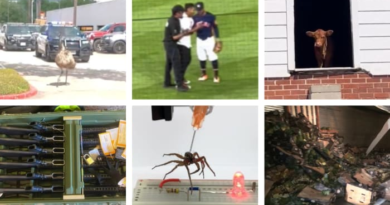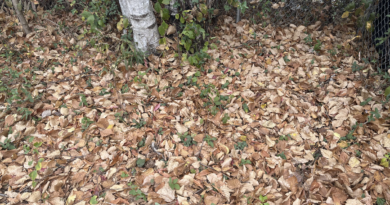Wade’s Wonderland of Salvage and Scrap, Atco – Weird NJ
Your Travel Guide to New Jersey's Local Legends and Best Kept Secrets
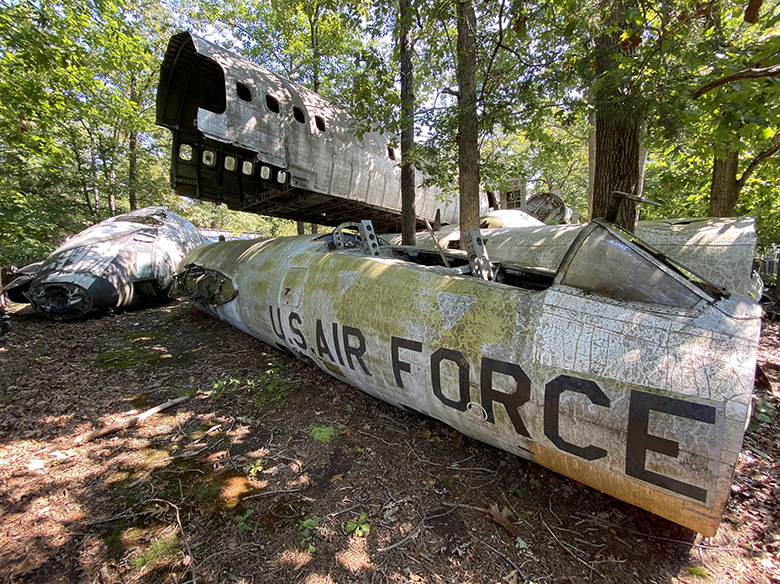
Wade’s Wonderland of Salvage and Scrap
There are many strange sights to be seen while traveling along the backroads of New Jersey’s Pine Barrens; blue holes, ghost towns – you may even catch a glimpse of the Jersey Devil himself! Perhaps just as unexpected as these things though, is the image of a U.S. Air Force C-130 cargo plane precariously perched atop a mountain of debris in the middle of the woods. At first glance it looks like a tragic crash site – parts of fuselage, wings and jet engines are strewn around the forest floor along with various other detritus. Nearby more planes and helicopters balance on top of school buses in a tangled heap of mangled metal. But fear not, this is not the scene of a devastating aviation disaster, this is actually one man’s pride and joy.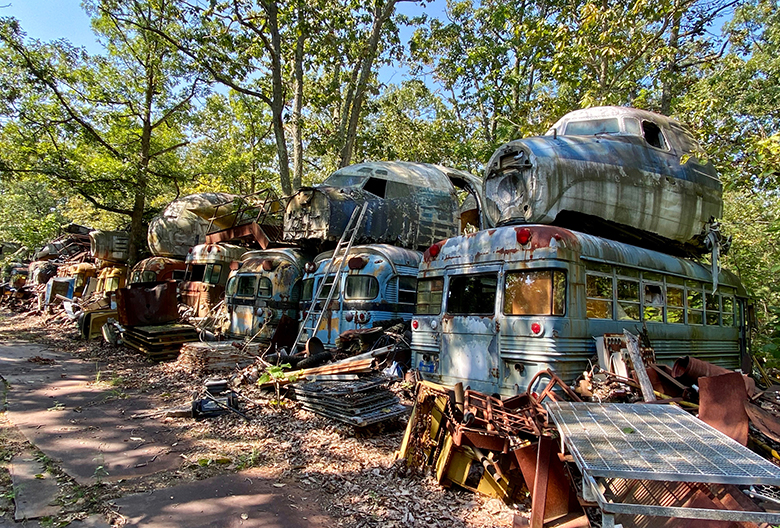
The place is Wade’s Salvage yard and the man is Andy Wade. Wade’s is a 12-acre junkyard located along Jackson Road in Atco (Waterford Township, Camden County) that would put Sanford and Son’s to shame. It’s a graveyard of antique tractors, gasoline pumps, military aircraft and scrap metal, all decomposing on the sandy soil of the Pine Barrens as the forest encroaches around it. The vast labyrinth consists of canyons of iron and aluminum, dozens of vintage cars and buses, the hollowed-out carcasses of about 100 airplanes, including a four propeller Douglas DC-3 airliner, and even one steel burial casket…only used once!
The vast labyrinth consists of canyons of iron and aluminum, dozens of vintage cars and buses, the hollowed-out carcasses of about 100 airplanes, including a four propeller Douglas DC-3 airliner, and even one steel burial casket…only used once!
While some men may hunt for trophy game animals, Andy Wade’s trophies are the thousands of items of refuse that he’s collected – and he seems to have a tale to tell for each one. Weird NJ paid Mr. Wade a visit late last summer where he shared the story of his salvage business with a great sense of pride.
“My grandfather started it right in this location around 1940,” Andy, who’s 51-years old, told us while chomping on a thick cigar. “Just seems to keep on growing. When I graduated from high school in 1980 my father and I just started working the business, we all worked together, me, mom, dad.” These days Andy continues on in the family tradition along with is nephew Gregory Sharp, 44. We asked the men how they came to have so many military surplus items at the junkyard.
“I had put a bid in on some airplanes for I think $20 bucks each and I got them. Me and my dad cut them up, put them on trucks and trailered them back here. So we started bidding on military scrap from different locations, like Maguire (Air Force Base) and Lakehurst (Naval Base), and Aberdeen Proving Grounds (U.S. Army, Maryland).”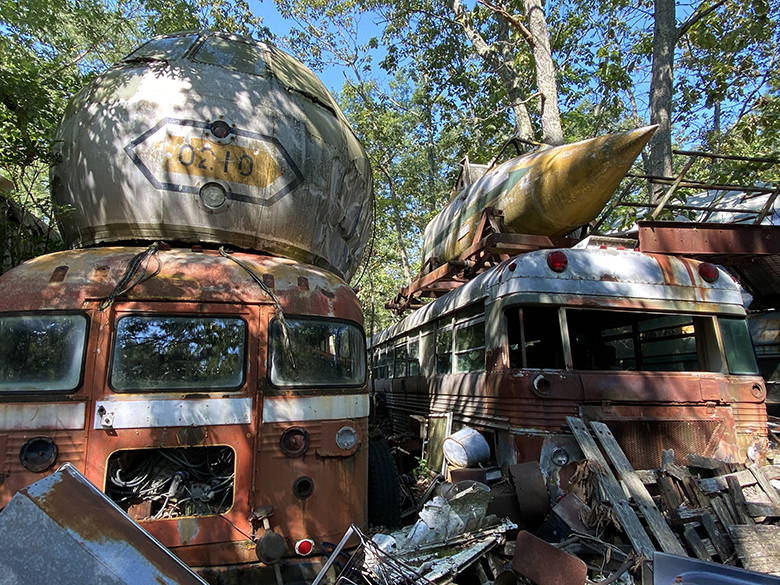
As planes become obsolete on bases around the country, due to the fatigue to their metal and parts, they are decommissioned or “timed-out.” That’s when Andy Wade, who says he’s the “preferred airplane chopper in the region,” swoops in to collect his trophies. Some of those prizes are now part of this collection, including a Korean War era F-86 Sabre and two Vietnam War veterans – an F-4 Phantom, and an A-4 Skyhawk fighter jet.
Not all the of the planes end up in Wade’s permanent collection though, many do get chopped and scrapped. Parts are separated according to the metals they contain and then packaged up and sent to companies that buy aluminum, stainless steel, nickel, or copper. Of course, chopping up military equipment is not without its risks and both Andy and Gregory have had some close calls and suffered bodily injury.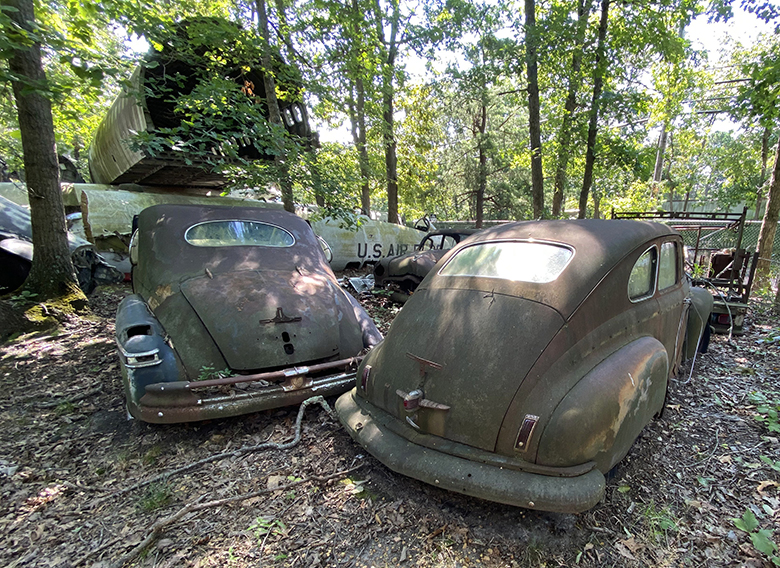
“Most of the time these military planes are crashed or wrecked,” Andy explains. It’s not like they just pulled them off the runway then you’re tearing up. A lot of these planes had live rounds of ammunition in them. I had one blow up or on me in Virginia.”
Before any armaments can be turned over to be disposed of the military must first declare that it’s safe. Any fuel is supposed to be drained and explosives removed. Then when it’s sold to a contractor, such as Wade’s, they come in and give it another safety inspection. Then the contractor is issued what’s known as a ‘burn permit’ to dismantle the ordnance with a torch or saw. Despite all of these safety precautions though, mistakes do still happen. Like the time in 1982 when Andy was dismantling a Korean War-era reconnaissance jet and sawed into a reserve fuel tank that had been forgotten about.
“There was still jet fuel in the belly of this plane. We were using a big grinder blade and that sent a flame right off the side of my face and in my ears. Another time there was a phosphorus bomb. That’s something that lights up on impact and it’s very hot. I cut into that with my torch and it blew up. The heat built up in the metal and set the bomb off. I got third degree burns through my blue jeans on my left side from my knees to my head. And it was so hot that it took the branches off a cedar tree next to the plane. So, we wound up getting free helicopter ride up to Walter Reed Hospital. They checked me out and I was okay, so I just walked out and went back to work on that plane. We finished the job and drove home that night.”
Andy’s nephew Gregory is not without his own battle scars. In 1986 he was cutting up the cockpit of a bomber jet at the Atco yard when a canopy pin shot into his upper right arm. The plane had small explosives charges, which were designed to blow the canopy off the cockpit when the pilot pressed the ejector seat button.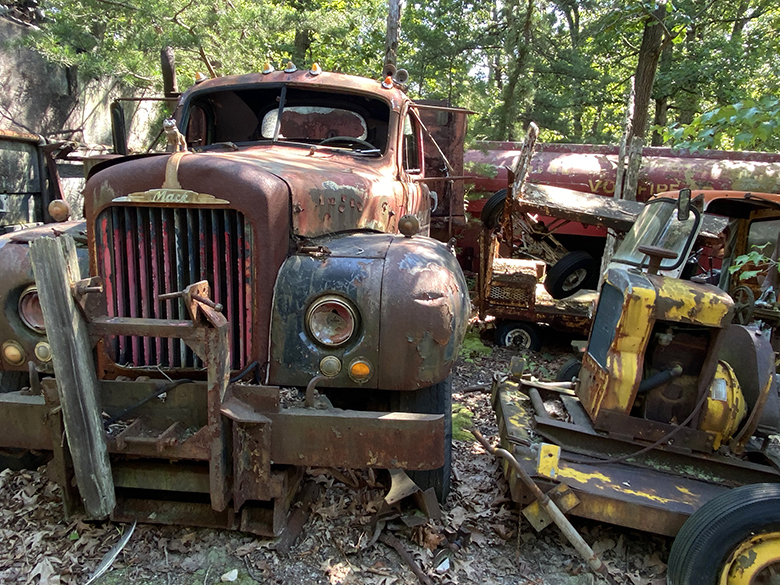
“It’s like a little dynamite cap that was still left in there.” Gregory grimaces as he remembers hitting the charge that sent the stainless-steel pin into his arm like a bullet. The wound required another trip to the emergency room and left a noticeable scar where the doctors pulled it from his bicep…but at least it wasn’t lodged in the center of his forehead.
“It’s somewhat dangerous because you’re dealing with stuff that’s wrecked,” he admits. “So, you just don’t know. But with a lot of the military stuff, you know they’re not going to tell you all their secrets.”
One of the first things you notice when approaching Wade’s main gate is the rusting hulk of a locomotive engine which was came from Lakehurst Naval base. It was once used to tow the ill-fated Nazi Zeppelin Hindenburg from its mooring tower to Hangar No. 1 during trips prior to its historic 1937 explosion.
“We bought that from the guy that lived on 206.”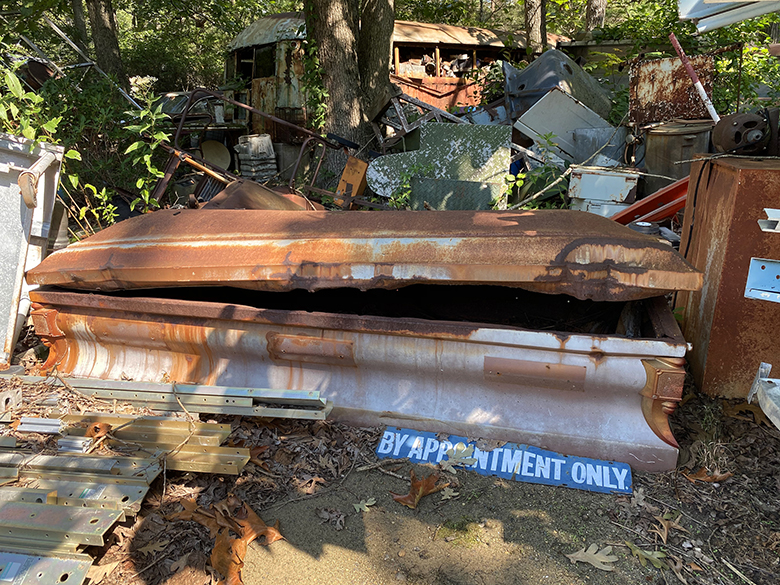
Andy is referring to John Val Jean Mahalchick, who operated a junkyard in Mt. Holly, NJ from the 1960s to the ’80s. The 50-acre property contained a massive arsenal of military surplus items, which Mahalchick had acquired from nearby bases like Forts Dix and McGuire. An eccentric character, he posted crudely painted sheet metal signs all along the property facing Route 206 that featured political rants targeting politicians of the day, as well as “commies”, socialists, draft dodgers and the wealthy. Mahalchick lived in an enormous sheet mental tee pee he’d constructed in the heart of the junkyard. He also ran two unsuccessful campaigns to become President of the United States, in 1972 and ’76.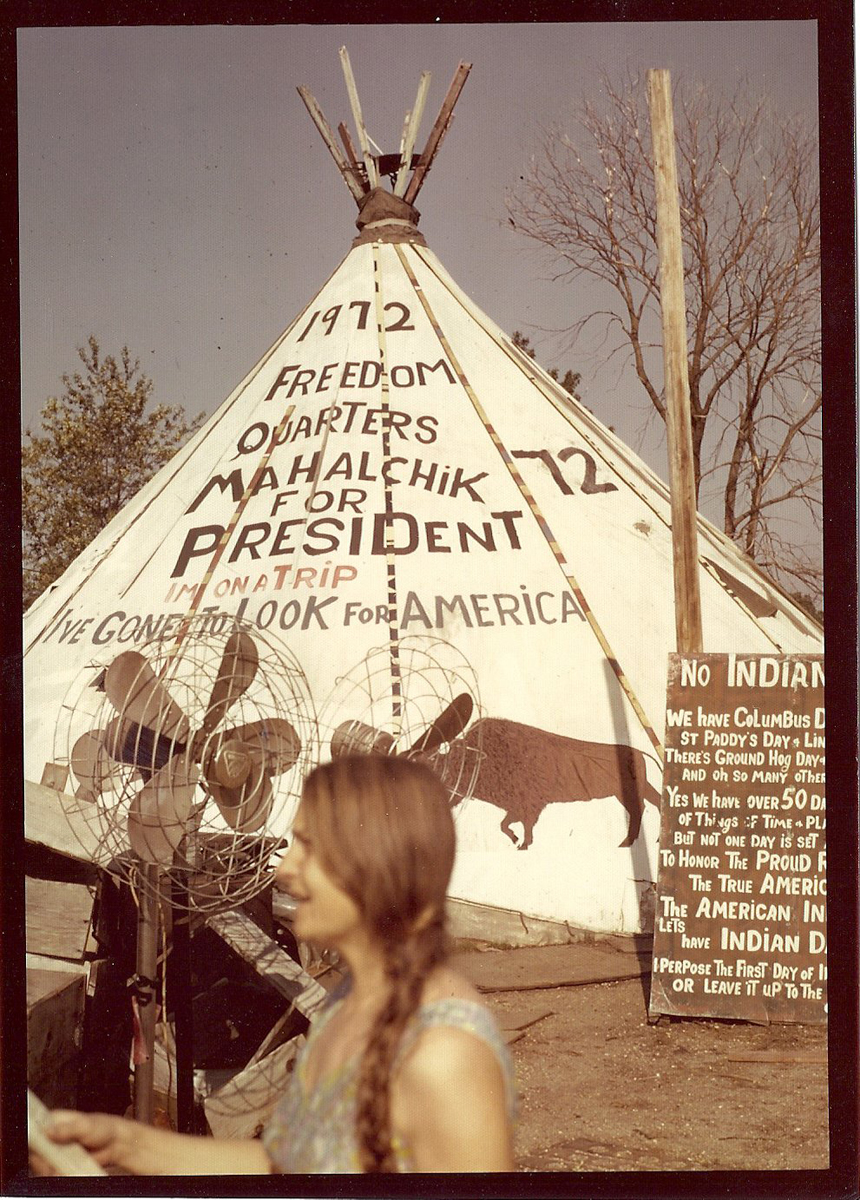 “Oh, yeah. He was quite a character!” Andy remembers with a chuckle. “The people from the film Eddie and the Cruisers went to him, he was still in business then, and he showed them he was a juggler. He picked up some old pony poop and started juggling. Then after he grabbed a couple of girls’ behinds, they’re like, well, we can’t deal with this guy. I guess he squeezed a couple of ladies pretty good.”
“Oh, yeah. He was quite a character!” Andy remembers with a chuckle. “The people from the film Eddie and the Cruisers went to him, he was still in business then, and he showed them he was a juggler. He picked up some old pony poop and started juggling. Then after he grabbed a couple of girls’ behinds, they’re like, well, we can’t deal with this guy. I guess he squeezed a couple of ladies pretty good.”
Eddie and the Cruisers is a 1983 musical drama film about a fictional New Jersey rock and roll band that gets its start at a Somers Point club called Tony Mart’s (an actual club, is now defunct). In the movie a television reporter investigates the mysterious disappearance of legendary rock star Eddie Wilson. Flashbacks dramatize Eddie’s life and the rise and fall of his band, Eddie and the Cruisers. Some scenes in the film were shot in a junkyard which Eddie, played by Michael Paré, calls the Palace Depression.
The Palace Depression (or Palace of Depression) was a very real, and really bizarre, home constructed from junk in Vineland, NJ, by an enigmatic drifter named George Daynor. Daynor built it entirely out of trash he’d gathered from a local dump during the Great Depression.
“So they (location scouts for the film) came to us. They were looking for a junkyard scene. But something that wasn’t like all cars, something that wasn’t all scrap. They were looking for a true salvage yard, somebody with a little bit of everything. And that was us. They basically rented the whole yard for a couple months to set up the scenes and then filmed. They built this sort of a monument out of junk.”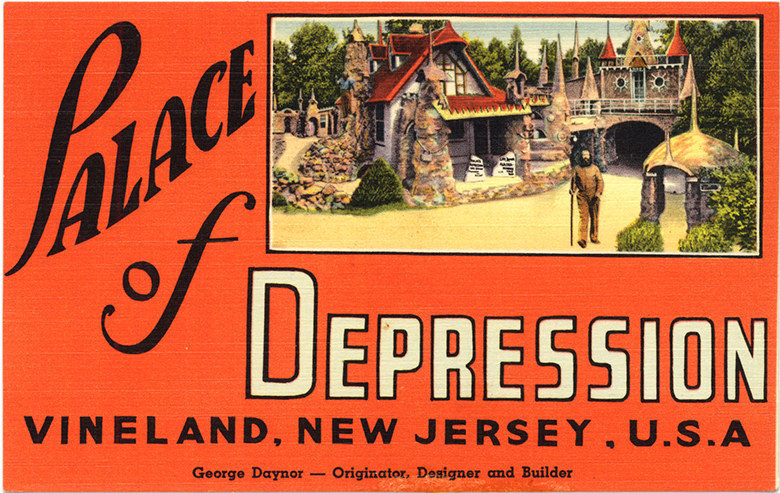
The movie features a cathedral-like shrine constructed from a hodgepodge of car parts and other junk, which, while it bears little resemblance to the actual Palace Depression, was nevertheless quite impressive.
Did you have to disassemble that after they were done, we wondered?
“No, it’s actually still back there, really buried in a big pile.” Andy said, gesturing to a massive tangled heap of twisted metal. After Eddie and the Cruisers more film companies would seek to incorporate Wade’s unique collection into their movies. Some of the other films Wade’s has provided scenery props for include; the 1995 film Twelve Monkeys starring Bruce Willis, The Invasion with Nicole Kidman in 2007, in which some of Wade’s aircraft were employed in a scene about a space shuttle crash, and in the Steven Spielberg-produced Transformers: Revenge of the Fallen in 2009.
“We did an airplane crash scene for Emergence out on the Jersey Shore. We did the second episode for Manifest, where the airplane blew up at the hangar in New York.”
While showbiz is always a fun sideline, scrap metal is still the primary enterprise of Wade’s Salvage. But it means that not every plane gets cut up into little pieces, because the company needs to keep some intact enough to rented out as props.
“It’s a little shot in the arm. You never know how many we’ll get though, so we kind of have to keep an eye on what they look for.”
Thanks to his ongoing relationship with the New Jersey Film and Television Commission refuse from Wade’s Salvage will no doubt continue to show up in big budget films in the future.
In addition to being an enterprising raconteur of rubbish, Andy Wade in now also the official Deputy Mayor of Waterford Township. He ran as an Independent and says that he probably knows every single person in the town.
“I’m not the smoothest around,” he confesses. “But if nobody hates you, then you’re not doing the job, right? I try to be fair with everybody and I tell people from the government side, I said, I hate government. You get a lot of people that get elected and they don’t know how to run stuff. And it’s just something that was on their bucket list. I hate Uncle Sam in my back pocket constantly, and that’s part of the reason why I got involved. I don’t want to be an elected official, but I had the circumstance. I’ve been fighting this town all my life. There are different loons that don’t like me. I said, you know what, let me jump in.”
Before bidding farewell to Wade’s Salvage, we asked Andy if there was anything in his vast collection that was a particular source of pride for him. One of his favorites he told us was the Convair 880 passenger plane, which he says may have once been piloted by eccentric billionaire Howard Hughes. Another of his prized possessions is a rusted old jalopy with running boards that looks like it once belonged to a Prohibition era gangster…and Andy explains he believes it actually did!
“This car I bought at the John Mahalchick auction when he died. He bought it from a treasury auction out of New York, so it had to be a bootlegger’s car that was seized during Prohibition. And I guess sometimes stuff sits in warehouses for years. And he bought this along with a Cadillac. The Cadillac sold for a lot of money to somebody else, but I bought this. It’s a 1928 Graham Paige, which eventually became Plymouth down the road. So, it’s gotta be some bootlegger’s car – could’ve been Al Capone’s or Legs Diamond’s!”
We wondered if Andy would you ever sell something like this, or was it was too near and dear to him.
“No, everything’s for sale, because I’m not gonna live forever.”
So, what does the future look like for Wade’s salvage?
“We’re gonna pass it on. Little of this, little that, but just, you know, keep going.”
Recycle, repurpose, reuse, repeat.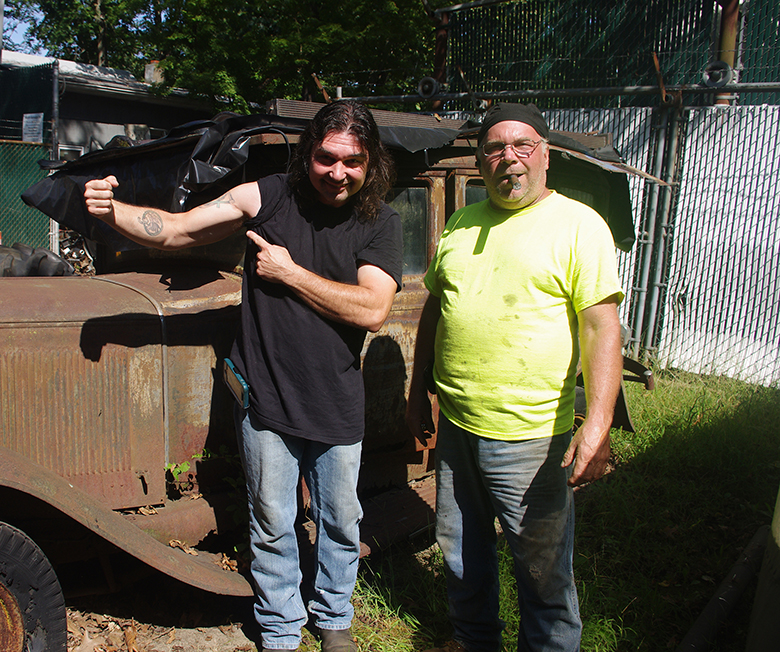
Photo Caption: Andy Wade (right) with Gregory Sharp, who points to a scar where a canopy pin pierced his arm while he was dismantling the cockpit of a U.S. Air Force fighter jet in 1986.
The preceding article is an excerpt from Weird NJ magazine, “Your Travel Guide to New Jersey’s Local Legends and Best Kept Secrets,” which is available on newsstands throughout the state and on the web at www.WeirdNJ.com. All contents ©Weird NJ and may not be reproduced by any means without permission.
Visit our SHOP for all of your Weird NJ needs: Magazines, Books, Posters, Shirts, Patches, Stickers, Magnets, Air Fresheners. Show the world your Jersey pride some of our Jersey-centric goodies!
Now you can have all of your favorite designs from the past on all kinds of cool new Weird Wear: Men’s Wear, Women’s Wear, Kids, Tee Shirts, Sweatshirts, Long Sleeve Tees, Hoodies, Tanks Tops, Tie Dyes, Hats, and accessories like Mugs, Backpacks, Stickers, Buttons and more! All are available in all sizes and a variety of colors.
Represent Jersey!
![]()
![]()
![]()
![]()
![]()
![]()
Your email address will not be published.

